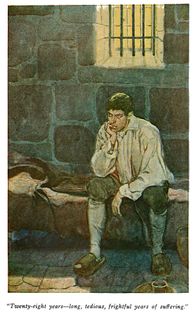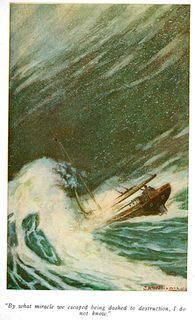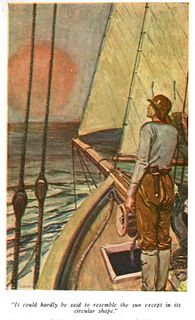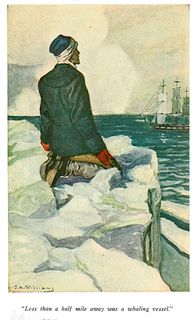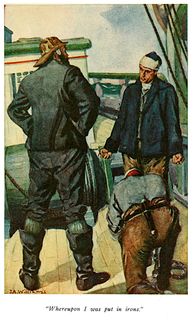The Smoky God (1908 novel)
From Kook Science
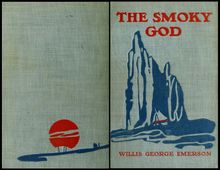 Reverse and front covers of 1908 ed. | |
| Author | Willis George Emerson |
|---|---|
| Illustrator | John Alonzo Williams |
| Publisher | Forbes & Co. |
| Location | Chicago |
| Pub. date | 1908 |
| Language | English |
The Smoky God, or A Voyage Journey to the Inner Earth is a 1908 novel by Willis George Emerson, relating what is purported to be a true account of Olaf Jansen, a Norwegian sailor, who travels with his father into the hollow earth through an entrance at the North Pole. The original editions featured accompaniment illustrations by John Alonzo Williams, including depictions of the gigantic inhabitants of the cavern world.
Editions
- Emerson, Willis George (1908), The Smoky God, Chicago: Forbes & Company, https://catalog.hathitrust.org/Record/010942976
- Emerson, Willis George (1964), The Smoky God, New York: Fieldcrest
- Emerson, Willis George (1965), The Smoky God, Amherst, Wis.: Palmer Publications
Synopsis
The story was serialised in The National (Chapple Publishing Co.) from December 1907 to March 1908, in which the following synopsis of the novel was given:
In his Foreword, published in the December number of the National, the author comments upon the undying interest which men have ever evinced regarding the hidden secrets of the frozen Northland. He recounts many of the well-known, and advances some new and interesting arguments founded on material proofs leading to the inevitable conclusion that there is still another and a grander continent somewhere "beyond the North Wind."
At two o'clock, one morning he was summoned to the bedside of Olaf Jansen, an aged Norseman who, some years before, had established his home in an outlying section of Los Angeles, California. The old Norseman was about to die, but before the end came he told the author of this narrative of his marvelous voyage to the "Inner World," made by his father and himself many years before.
A detailed story of the voyage written by the old Norseman himself, with data, drawings, and crude maps, were given to the author of this narrative with the understanding that they should be offered to the world after the old Norseman's death, that the mystery of the frozen Northland might be forever cleared away. In the old Norseman's story it is set forth that during the wonderful voyage which he so graphically describes, his father was drowned, and the son, on telling the captain of the whaling vessel which rescued him in the Antarctic Ocean, of his mysterious adventures, was believed to be a madman. Later he was permitted to return to Stockholm from whence he had started and there told his story in detail to his uncle who had him confined in a madhouse, where he remained for twenty eight years — long, tedious, frightful years of suffering! He was finally released and after many years spent as a fisherman and a student of books he came to America where he wrote the story of his voyage. In this he details how he and his father sailed from Stockholm to Franz Joseph Land from which point they dared to sail still on toward the mysterious land "beyond the North Wind." After thrilling adventures among icebergs and days of sailing in more open waters, an awful tempest of wind and snow which nearly sunk their sloop was followed by strangely mild, fair weather. One day, when Olaf was sleeping, his father roused him, saying, "There is land in sight." This land proved to be the outskirts of the "Inner World," and from the time huge men twelve feet in height came to their little sloop, took it bodily from the water and carried it on board a massive ship to the marvelous country and cities they inhabit, the two voyagers were filled with awe and wonder. They were treated with gentleness and courtesy. Great cities, vast waterways, evidence of advanced learning and marvels of every kind greeted them as they were conducted through the "Inner World."
At the conclusion of Jansen's account, the time and date of his manuscript's completion is given as "one hour past midnight — the new year of 1907," on the "third day thereof;" and, on that same day, Jansen was said to have passed away. Based on Emerson's statement that Jansen had "recently celebrated his ninety-fifth birthday," we may surmise his year of birth was 1812.
Referred Works and Persons
- In the "Author's Foreword," Emerson refers to Paradise Found: The Cradle of the Human Race at the North Pole (1885), saying that the author William F. Warren had "almost stubbed his toe against the real truth, but missed it seemingly by only a hair's breadth, if the old Norseman's revelation be true."
- Emerson also quotes one Orville Livingston Leech, who compares the Earth to a geode as evidence of the planet's hollowness.
- Emerson quotes M. le Marquis Gaston de Saporta's article "How the Earth Was Peopled" (Popular Science Monthly, October 1883, v. 23, p. 753): "It follows that man issuing from a mother-region still undetermined but which a number of considerations indicate to have been in the North, has radiated in several directions; that his migrations have been constantly North to South;" to which Emerson adds his own observation that "as we approach the Equator, the stature of the human race grows less," making exception for the Patagonians of South America as "probably the only aborigines from the center of the earth who came out through the aperture usually designated as the South Pole, and they are called the giant race."
- Jansen mentions toward the end of his narrative that he believed Strindberg and Fraenckell (Nils Strindberg and Knut Frænkel) had made it to the Inner World during the course of their expedition to reach the geographic North Pole in a hydrogen balloon (orchestrated and led by S. A. Andrée), the fate of which had, in 1907, remained unknown and were the object of popular speculation; in 1930, the remnants of the expedition's final camp, and the remains of the explorers, were found on Kvitøya (White Island) in the Svalbard archipelago of Norway.
Illustrations

